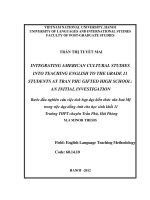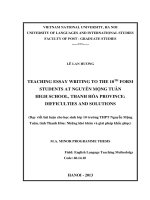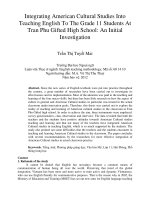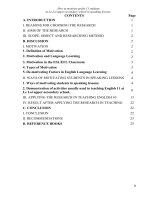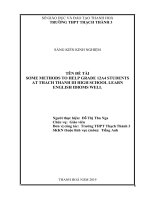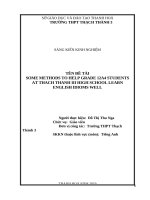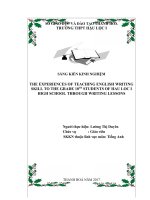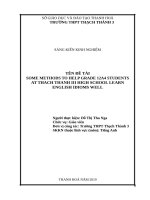Integrating American Cultural Studies Into Teaching English To The Grade 11 Students At Tran Phu Gifted High School An Initial Investigation = Bước đầu nghiên
Bạn đang xem bản rút gọn của tài liệu. Xem và tải ngay bản đầy đủ của tài liệu tại đây (1.47 MB, 71 trang )
VIETNAM NATIONAL UNIVERSITY, HANOI
UNIVERSITY OF LANGUAGES AND INTERNATIONAL STUDIES
FACULTY OF POST-GRADUATE STUDIES
TRẦN THỊ TUYẾT MAI
INTEGRATING AMERICAN CULTURAL STUDIES
INTO TEACHING ENGLISH TO THE GRADE 11
STUDENTS AT TRAN PHU GIFTED HIGH SCHOOL:
AN INITIAL INVESTIGATION
Bước đầu nghiên cứu việc tích hợp dạy kiến thức văn hoá Mỹ
trong việc dạy tiếng Anh cho học sinh khối 11
Trường THPT chuyên Trần Phú, Hải Phòng
M.A MINOR THESIS
HANOI –2012
Field: English Language Teaching Methodology
Code: 60.14.10
VIETNAM NATIONAL UNIVERSITY, HANOI
UNIVERSITY OF LANGUAGES AND INTERNATIONAL STUDIES
FACULTY OF POST-GRADUATE STUDIES
TRẦN THỊ TUYẾT MAI
INTEGRATING AMERICAN CULTURAL STUDIES
INTO TEACHING ENGLISH TO THE GRADE 11
STUDENTS AT TRAN PHU GIFTED HIGH SCHOOL:
AN INITIAL INVESTIGATION
Bước đầu nghiên cứu việc tích hợp dạy kiến thức văn hoá Mỹ
trong việc dạy tiếng Anh cho học sinh khối 11
Trường THPT chuyên Trần Phú, Hải Phòng
M.A MINOR THESIS
HANOI – 2012
Field: English Language Teaching Methodology
Code: 60.14.10
Supervisor: VŨ THỊ THU THỦY, M.A
iv
TABLE OF CONTENTS
DECLARATION …………………………………………………………… ……….i
ACKNOWLEDGEMENTS …………………………………………….…………….ii
ABSTRACT ………………………………………………………………………….iii
TABLE OF CONTENTS …………………………………………………………….iv
LIST OF TABLES ……………………………………………………………… …vii
LIST OF FIGURES ……………………………………………………… …….…viii
PART I:
INTRODUCTION…………………………………………………………………….1
1. Rationale of the study………………………………………………………… 1
2. Aims of the study…………………………………………………………….…3
3. Research questions…………………………………………………………… 3
4. Scope of the study…………………………………………….……………… 4
5. Significance of the study…………………………………………………….…4
6. Method of the study………………………………………………………….…4
7. Design of the study…………………………………………………………… 5
PART II: DEVELOPMENT ……………………………………………………… 5
CHAPTER 1: LITERATURE REVIEW ……………………………………….….6
1. Language and Culture
1.1. What is language …….……………………………………….… …………….6
1.2. What is Cultural studies? ………………………,,,…………………………….6
1.3. Cultural studies in language teaching ……………… ………………….…….8
2. What are the main goals for teaching American cultural studies? …………………9
3. What are the principles for teaching American culture studies? ………………… 10
4. What are the most common approaches to the teaching of American Cultural
studies? ……………………………………………………………………………. …11
v
5. What are some techniques and activities for teaching American Cultural
studies? ……………………………………………………………………………… 12
6. Evaluating materials for teaching American Cultural studie…………………… 14
CHAPTER 2: RESEARCH METHODOLOGY……………….……………… …16
2.1. Overview of the current situation of teaching and learning American Cultural
studies
at Tran Phu Gifted High School. …………………………………….……….16
2.2. Methodology
2.2.1. Sample ………… ……………………………………….……………17
2.2.2. Data collection instruments ……………………………………… 19
2.2.2.1. Survey questionnaire ……………………………………………….19
2.2.2.2. Classroom observation ….……………….……………………… 21
2.2.2.3 Interview …………………………………………………………… 21
2.2.3. Data collection procedure…………………………………………….22
2.2.4. Data analysis procedure……………………………………………….22
2.3. Conclusion ………………………………………………………………… 23
CHAPTER 3: DATA ANALYSIS AND DISCUSSION …………………………24
3.1. Findings from questionnaires for the teachers ……………… … …… 24
3.1.1 The teachers‟ perceptions on the definition of American
Cultural studies ……………………………… …………… …….…24
3.1.2 The teachers‟ perceptions on the importance of teaching
American cultural studies in the classroom ………………………….24
3.1.3 Frequency of teaching the culture-related issues ………………… .25
vi
3.1.4 The teachers‟ way of teaching American Cultural studies in the
classroom …………………………………………………………… 25
3.1.5 The teachers‟ choice of topics for American Cultural studies in the
classroom ………………………………………………………………26
3.1.6 The teachers‟ choice of materials of teaching American Cultural studies
in the classroom ……………………………………………………… 27
3.1.7. The teachers‟ opinions about difficulties in teaching American Cultural
studies in the classroom ……………………………………………….29
3.2 Findings from questionnaires for the students ………………………………31
3.2.1 The students‟ perception of the importance of learning American
Cultural studies in the classroom …………………………………. …31
3.2.2 The students‟ opinions of the ways of teaching American Cultural
studies in the classroom …………………………………………… 31
3.2.3 The students‟ choice of topics for American Cultural studies in the
classroom …………………………………………………………… 33
3.2.4 The students‟ ways of gaining American Cultural studies knowledge
…………………………………………………………… ………….35
3.3. Findings from class observations ……………………… …………………36
3.4. Findings from the interview ……………………………………………… 37
3.5. Discussion of the findings ………………………………………………… 38
3.6. Conclusion ………………………………………………………………… 40
PART III: CONCLUSION ………………………………… ……………………41
1. Summary of the study …………… …………….…………………………….41
vii
2. Pedagogical implications ……………………….…………………………….41
3. Limitations of the study ……………………………………………………….43
4. Suggestions for further study………………………………………………….44
5. Conclusion…………………………………………………………………… 45
REFERENCES ……………………………………………………… ………… 45
APPENDICES……………………………………………………………………… I
Appendix 1: Survey questionnaire for the teachers ………………………………I
Appendix 2: Survey questionnaire for the students ………………………………V
Appendix 3: Interview Questions ……………………………………………… VIII
Appendix 4: Suggested lesson plan …………………………………………… IX
viii
LIST OF TABLES
Table 1: Characteristics of the teachers
Table 2: Difference between the teachers‟ and students‟ opinions about the ways of teaching
American Cultural studies in the classroom
Table 3: Difference between the teachers‟ and students‟ scores for topics of teaching American
Cultural studies in the classroom
LIST OF FIGURES
Figure 1: The teachers‟ scores for the ways of teaching Americans studies in the classroom
Figure 2: The teachers‟ scores for the topics of teaching American Cultural studies in the
classroom
Figure 3: The teachers‟ scores for materials for teaching American Cultural studies in the
classroom
Figure 4: Difficulties in teaching American Cultural studies in the classroom
Figure 5: The students‟ score for the ways of teaching American Cultural studies in the
classroom
Figure 6: The students‟ score for the topics of teaching American Cultural studies in the
classroom
1
PART I: INTRODUCTION
1. Rationale of the study
It cannot be denied that English has nowadays become a common means of
communication of human being all over the world. Perceiving that trend of the global
integration, Vietnam has been more and more active to train active and dynamic
Vietnamese, who can use English fluently for communicative purposes. That is the
reason why in 2002, the Ministry of Education and Training (MOET) has set out new
aims for English language teaching for secondary education as well as introduced new
series of English textbooks from grade 6 to grade 12.
The new English textbooks for high school students are divided into two sets:
the advanced and the standard. Each unit in the new English textbooks consists of five
parts: Reading, Speaking, Listening, Writing and Language Focus, among which the
Language Focus sections are to consolidate students‟ pronunciation and grammar.
They are claimed to adopt the latest teaching and learning approaches: communicative
approach and learner-centered approach and aim at developing both language skills and
language knowledge for students.
Since their nation-wide implementation in the school year 2006-2007, a great
number of researchers have been carried out to evaluate these new textbooks as well as
to find out how these textbooks are actually implemented or the difficulties that
teachers and students at high schools have to face when teaching and learning with the
new textbooks. Most of these studies have dealt with the teaching and learning of the
four language skills which are believed to be new for both teachers and students.
However, there is still one more indispensable aspect which tends to be depreciated. It
is culture that turns out to be the fifth skill in language learning and tacked on to the
2
teaching of speaking, listening, reading, and writing. It always stays in the background
to decide the good language learners when paid enough attention to. It supports
learners to achieve their communicative competence. Nevertheless, the number of
research on the teaching and learning of culture in general and America studies in
particular in the classroom is obviously limited. It is necessary to carry out more
research on how teachers and students teach and learn culture in the actual classroom.
Besides, national examinations (national examinations for GCSE, university
entrance examinations) have currently included some questions related to American
cultural studies issues (for example: how to address certain situations, etc.)
On the other hand, there are various cultures that English language is getting
connected with. Among those, the United States has a leading economic, political and
cultural force in the world. Moreover, the United States is also the ideal destination for
overseas students, which has resulted from its top-ranking education system. Thus,
learning about the culture of the United States appears to be a wise choice.
Moreover, after two years of teaching English with the new English textbooks at
Tran Phu Gifted High School, the researcher observed that the teachers and learners
there faced a number of difficulties in teaching and learning American cultural studies
in the classroom.
According to Bada (2000: 101), “the need for cultural literacy in ELT arises
mainly from the fact that most language learners, not exposed to cultural elements of
the society in question, seem to encounter significant hardship in communicating
meaning to native speakers.” In addition, nowadays the L2 culture is presented as an
interdisciplinary core in many L2 curricula designs and textbooks (Sysoyev &
Donelson, 2002).
3
Stimulated by the above reasons, the researcher has decided to conduct this
study. It is hoped that this study will discover the reality of teaching and learning
American cultural studies at Tran Phu Gifted high school in order to contribute some
immediate solutions.
2. Aims of the study
The aim of this study is to examine the current teaching and learning of American
cultural studies in the high school classroom at Tran Phu Gifted High School.
In order to achieve the aim, the study seeks to find out:
(1) The teachers‟ and students‟ perceptions on the importance of American cultural
studies teaching and learning
(2) How the teachers and the students deal with American cultural studies in the
classroom
(3) The teachers‟ perceived difficulties in teaching and learning American cultural
studies in the classroom
3. Research questions:
To achieve the aim and objectives of the study, the following research questions were
proposed:
1. How do the teachers and the students at Tran Phu Gifted High School perceive
the importance of American cultural studies teaching and learning?
2. How do the teachers teach and the students learn / expect to learn American
cultural studies in high school classroom?
3. What method and techniques do the teachers and the students use / expect to
use?
4
4. What are the difficulties in teaching and learning American cultural studies as
perceived by the teachers?
4. Scope of the study.
This study is limited to the teaching and learning reality with regard to teaching
and learning American cultural studies in the classroom.
This study is a detailed survey at Tran Phu Gifted High School in Hai Phong.
Therefore, the findings of the study are not intended to be generalized to other school
contexts. Indeed the findings may not apply beyond the actual participants in this
particular study.
5. Significance of the study
This study helps to identify the problems and suggests ways of improving them;
therefore, it is hoped that this study will be beneficial in many ways. First, participants
in the study (the teachers and the learners at Tran Phu Gifted High School) will benefit
immediately from the experience of reflection. Secondly, the findings of the study will
contribute information to textbook writers and educators to determine curricula and
program direction.
6. Method of the study
The study was designed to use both quantitative and qualitative methods. Then,
various instruments were used to collect the data for the study from different sources:
- survey questionnaires to investigate the teachers‟ and students‟ attitudes towards
American cultural studies, their teaching and learning habits and their difficulties in
teaching and learning American cultural studies in the classroom
5
- class observations to get information about both the teachers‟ methods of teaching
and students‟ ways of learning American cultural studies in the classroom.
- interviews with the teachers to get in-depth information about the teachers‟ and the
grade 11 students‟ suggestions to improve the teaching and learning of American
cultural studies in the classroom.
7. Design of the study
The study is divided into three parts: Introduction, Development and
Conclusion.
The Introduction presents an overview of the study including the rationale,
aims, scope, significance, methodology and design of the study.
The major part of the study, the Development, is divided into three chapters.
Chapter one provides theoretical background for the study. Chapter two presents the
methodology of the study and the last chapter is devoted to analyzing and discussing
the findings of the study.
The Conclusion part provides a brief summary of the findings in
correspondence with the four proposed research questions as well as offering some
recommendations for better American cultural studies teaching and learning. The
limitations of and suggestions for further study are also discussed in this chapter.
Besides, the survey questionnaires for the teachers and students and the
suggested lesson plan are included in the Appendices.
6
PART II: DEVELOPMENT
CHAPTER 1: LITERATURE REVIEW
1. LANGUAGE AND CULTURE
1.1. WHAT IS LANGUAGE?
Language has been around since human beings started to communicate with one
another for their daily life needs. The term language is so familiar that few people
would ever try to define it. It is superficially not hard to define it, but in fact to have a
comprehensive definition of language is an extremely daunting task. Definitions for
language run the gamut from very simple to extremely complex. Patrikis (1988) simply
defined language as signs that convey meanings. Language is also “a system of signs
that is seen as having itself a cultural value” (Kramsch, 1998, p. 3). From a linguistic
perspective, Sapir (1968), a renowned linguist, defined language as an entirely human
and non-intrinsic method of communicating ideas, emotions, and desires by means of a
system of voluntarily produced symbols. Generally speaking, language can be regarded
as a system of verbal and nonverbal signs used to express meanings. Besides language,
another closely related concept that is sometimes mentioned in the literature of
language teaching is culture.
1. 2. WHAT IS CULTURAL STUDIES?
Cultural studies is an exciting and “hot” field of study. It has become the rage
amongst progressive of all sorts – not least because culture as a theme or topic of study
has replaced society as the general subject of inquiry among progressive. Cultural
studies has made its presence felt in academic work within the arts, the humanities, the
social sciences and even science and technology. It appears to be everywhere and
7
everyone seems to be talking about it. And being aware of what exactly cultural studies
involves being conscious of what culture is.
Culture is a multidimensional concept. Concerning the terms “culture”, several
researchers have attempted to define it. The very term culture seems rather
controversial. Culture, can be viewed from a variety of angles, depending on whether
we take into account tits oral, or written aspects, whether we look at highbrow, or
popular culture, and whether we focus special events or everyday life and practices.
One of the well-known definitions of culture is Goodenough‟s (1957, p. 167):
…a society‟s culture consists of whatever it is one has to know or believe in order to
operate in a manner acceptable to its members, and to do so in any role that they accept
for any one of themselves.
Brown (2007, p. 188), however, defined culture as a way of life, as the context
within which people exist, think, feel, and relate to others, as the “glue” that binds
groups of people together. Moreover, culture, as Brown (2007) suggested, can also be
defined as the ideas, customs, skills, arts, and tools that characterize a certain group of
people in a given period of time.
Additionally, Mead (1961, p. 90) postulated that culture can be learned, whereas
Fox (1999) noted that “culture is relative and changeable in space and time”. Like
language, culture may seem to be another concept that is not easy to define. In fact,
Tang (2006) rightly observed that despite the continued efforts in various disciplinary
fields to find a definition for the term culture, at the present time there is no single
definition that satisfies everyone.
In conclusion, culture is a powerful human tool for survival, but it is a fragile
phenomenon. It is constantly changing and easily lost because it exists only in our
minds. Our written languages, governments, buildings, and other man-made things are
merely the products of culture. They are not culture in themselves. In other words, it
8
can be noted that culture seems to be (almost) everything and cultural studies the study
of (almost) everything. Thus, the definition of cultural studies cannot be misconstrued
on the assumption that it is not simply the study of different cultures. Actually, it uses
many other studies to analyze different cultures such as philosophy, theology,
literature, etc. Cultural studies helps discover how and why cultures are formed and the
reason groups of people act the way they do.
1.3. CULTURAL STUDIES IN LANGUAGE LEARNING
Both language and culture are concepts that seem to have posed great
difficulties for scholars to define. Besides, there seems to be an inevitable relationship
between these two concepts. Shaul and Furbee (1998) stated that languages and
cultures are systematic to a large degree, and are thus observable and describable.
Furthermore, many authors have pointed out that language and culture are closely
related (Ardila-Rey, 2008; Brown, 2007; Damen, 1987; Kuang, 2007; Kramsch, 1998;
Tang, 1999). For example, Ardila-Rey (2008, p. 335) maintained that: “Language and
culture are inextricably linked with each other.” Likewise, Brown (2007) pointed out
the interrelatedness of language and culture:
Language is a part of a culture, and culture is a part of the language; the two
are intricately interwoven so that one cannot separate the two without losing
the significance of either language or culture. The acquisition of a second
language, except for specialized, instrumental acquisition (as may be the case,
say, in acquisition of reading knowledge of a language for examining scientific
texts), is also the acquisition of a second culture” (p. 189-190).
The dialectical correlation between language and culture has always been a
concern of L2 teachers and educators. There are a number of studies aiming at the
seamless relationship between L2 teaching and target culture teaching. Over the last
decade, there are also a number of the scholars such as Byram (1989; 1994a; 1994b;
9
1997a; 1997b) and Kramsch (1988; 1993; 1996; 2001) who have begun to realize the
intertwined relation between culture and language teaching. It can be hard to learn a
language without knowing its culture. Learning a language has in fact been considered
as “inseparable from learning its culture” (Kuang, 2007, p.81).
More than two decades ago, Brown (1986) remarked that second language
learning in some respects involves acquiring a second identity, and that second
language learning is often equal to second culture learning. Brown (2007) again clearly
averred that acquiring a second language is acquiring a second culture.
Similarly, Seliger (1988) noted that culture is among the various factors that will
affect the rate and degree of second language teaching. He reasoned that because
language is employed in social exchanges, the feelings, attitudes, and motivations of
learners in relation to the target language, to the speakers of the language, and to the
culture will have an influence on how learners respond to the input to which they are
exposed.
To sum up, it has been emphasized that without the study of culture, teaching
L2 is inaccurate and incomplete. There exists a widespread consensus among scholars
that language and culture should not be treated as separate entities and culture should
be integrated into the language classroom. Language is seen as part of culture and
culture as part of language, which is why they cannot be separated and should be
taught together (Brown 2000:177). For L2 students, language study seems senseless if
they know nothing about the people who speak the target language or the country in
which the target language is spoken. Acquiring a new language means a lot more than
the manipulation of syntax and lexicon. That is to say, an analytic look at the native
culture is as important as the learning of the target culture.
2. What are the main goals for teaching American cultural studies?
When the main aim of foreign language teaching is to develop students‟ ability
to communicate effectively and appropriately in various situations, the teaching of
10
culture should facilitate intercultural communication and understanding. And, the
teaching American cultural studies in English classes doesn‟t make an exception.
According to Valette (1986), its cultural goals can be classified into four categories: (1)
developing a greater awareness of and a broader knowledge about American – the
target culture, (2) acquiring a command of the etiquette of American culture, (3)
understanding the differences between American culture and Vietnamese culture, (4)
understanding the values of American culture.
Additionally, Peterson and Coltrane (2003) indicated that cultural activities as
well as objectives should be carefully and clearly organized and incorporated into
lesson plans. These two authors even asserted that culture must be included as a vital
component of language learning.
3. What are the principles for teaching American culture studies?
Based on Kramsch‟s study (1993: 205 - 206), in which she highlights what she
calls “new ways of looking at the teaching of language and culture”, here are the
principles for teaching American cultural studies:
Establishing a “sphere of interculturality”, which means that teaching English
is not transferring information between cultures but culture should be put in relation
with its own. The intercultural approach includes a reflection on both cultures.
Teaching culture as an interpersonal process, which means replacing the
teaching of facts and behaviours by the teaching of a process that helps to understand
others.
Teaching culture as difference, which means considering the multi-culturality
and multi-ethnicity of modern societies and looking at various factors like age, gender,
regional origin, ethnic background, and social class. In other words, cultures should not
be seen as monolithic.
Crossing disciplinary boundaries, which means linking the teaching of culture
to other disciplines like anthropology, sociology and semiology.
11
In addition, there are some more aspects that might be considered while
teaching culture, for example, the teacher needs to be objective, get rid of clichéd
images and stereotypes, introduce are element of discovery learning, consider the
American dimension, and present cultural information in a non-judgemental fashion.
4. What are the most common approaches to the teaching of American
cultural studies?
Factors influencing the choice of methodology:
The situation in which the language is taught;
Learners‟ age and command of English;
The teacher.
The approaches can be classified in different ways.
In very broad terms, they can be divided into two: the mono-cultural approach
which focuses on (or mostly) on American cultural studies and the comparative
approach which are based on comparing American cultural studies and Vietnamese
studies. The first one is considered inadequate nowadays because it does not consider
learners‟ understanding of their own culture. The second one appears more
conventional for it tends to relate American culture to learners‟ own. The comparative
approach does involve evaluation but not in terms of comparison with something
which is better, but in terms of improving what is all too familiar (Byram and Planet,
2000, p.189). The comparative approach may begin either with the strange or the
familiar, yet some authors emphasize the need to deal with the familiar first and then
move to the strange. Through comparison, the students discover both similarities and
differences of American culture and their own culture. This, in turn, can lead to
increased knowledge, understanding and acceptance.
12
In addition to the above-discussed approaches, there are a number of approaches
that are centered around various aspects of American cultural studies or concentrate on
developing certain skills in learners. The following approaches concentrate on both
giving knowledge and understanding of American culture and encourage students to
compare it with their own.
The theme-based or thematic approach to the teaching of American cultural
studies is based around certain themes, for examples, symbolism, value, ceremony,
love, honour, beauty, intellectuality, the art of living, realism, common sense, family,
liberty, patriotism, religion, and education.
The topic-based approach concentrates on more general and cross-sectional
topics which involves various cultural issues.
The problem-oriented approach aims at getting learners interested in
American cultural studies and encourages them to do some research on their own.
The task-oriented approach is also based on students‟ own research.
Differently from the previous one it is characterized by co-operative tasks.
The skill-centered approach differs from the above-given approaches in a
sense that it is more practical and might be useful for those who need to live within the
target-language community. It aims at developing learners‟ skills, which they may need
to manage the issues involved in (mis)communication between cultures.
5. What are some techniques and activities for teaching American cultural
studies?
There is a great variety of techniques and activities developed for integrating
American cultural studies into English teaching. Many authors have proposed some
viable ways or approaches to teaching American to students. Blatchford (1986) argued
13
that newspapers could be vehicles to teach American cultural studies with the teachers‟
help and guide. Literature has also been considered a useful source for upper-
immediate and advanced students to have greater insight into the culture (Valdes,
1986). Scollon (1999) convincingly noted that commercial television can provide a rich
source to bring unconscious cultural codes to the level of conscious perception.
Krasner (1999) recommended some beneficial techniques and methods of
teaching American cultural studies: observation (through films, news broadcast, maps
or menus), having students visit ethic sections or restaurants of cities, mini drama
(which provides an example of miscommunication in the form of dramatization and the
students are asked to discover the cause of the miscommunication), culture capsule
(which offer brief explanations of foreign language customs, and culture capsule can
also be in the form of oral presentation, reading, writing, or visual aids or realia), and
role play (which gives the students opportunities to demonstrate and rehearse
appropriate cultural behavior).
According to Stern (1992), some instructional strategies to teach English and
American cultural studies that may seem helpful for teachers looking for some
practical ways to integrate American cultural studies in their English lessons.
creating an authentic classroom environment (techniques include, for example,
displays and exhibitions of realia);
providing cultural information (for example, cultural aside, culture capsule and
culture cluster);
cultural aside: an item of cultural information offered by the teacher when
it arises in the text
cultural capsule: a brief description of one aspect of American cultural
studies followed by a discussion of the contrasts between two cultures
cultural cluster: a combination of conceptually related culture capsules.
cultural problem solving (for example, culture assimilator);
14
cultural assimilator: similar to culture capsule, but assigned as a silent reading
exercise
behavioural and affective aspects (for example drama and mini-drama);
cognitive approaches (for example, student research);
the role of literature and humanities (for example, literary readings and
watching films);
real-life exposure to the target culture (for example, visits to the class by native
speakers, pen-pals and visits to other countries);
making use of cultural community resources (for example, when a foreign
language learning takes place in the target-language community, the everyday
environment can be used as a resource).
6. Materials for teaching American cultural studies.
Checklist for evaluating the cultural dimension in materials for teaching
American cultural studies.
Evaluating materials is a complicated process. Therefore, various materials
evaluation checklists have been provided to help teachers to choose teaching materials
that best meet the purposes of the teachers as well as the needs of students. Of all the
thorough checklists dealing with the cultural aspects in a more systematic way, Huhn‟s
(1978) is considered as a typical example. Based on his lists, the following criteria are
included:
Factual accuracy and up-to-date information;
Avoidance (or relativisation) of stereotypes;
Presentation of a realistic picture;
Freedom from (or questioning) ideological tendencies;
Presentation of phenomena in context rather than isolated facts;
Relevance of historical material to contemporary society;
15
Presentation of personalities as products of their age.
In addition, Sercu (1998), who also considers representativeness and realism as
the most important factors, suggests some questions for the teachers to focus on:
What image is presented: a royal or a realistic one?
Do the materials only present a tourist point of view?
Are negative and problematic aspects of American cultural studies touched
upon?
Do the materials offer an authentic reflection of the multicultural character of
the American society?
Do situations occur in which someone with a good mastery of English is not
understood because of differences in culture-specific reference frames?
Are teachers and learners encouraged to consult additional material on the topics
dealt with?
Are the materials written by members of the different nationalities living in the
foreign country or do they mainly present the white male point of view?
Are mentality, values, ideas dealt with?
Is a historical perspective presented and used to explain certain present-day
features of mentality or national character?
Is the information on American cultural studies integrated in the course or is it
added at the end of every lesson or even in presented in a separate chapter at the end of
the course?
16
CHAPTER 2: RESEARCH METHODOLOGY
2.1. Overview of the current situation of teaching and learning English at Tran
Phu Gifted High School.
Tran Phu gifted high school was founded twenty six years ago as a result of the
increasing demand of a gifted high school in the city. Despite the short period of
foundation, the school soon becomes one of the top schools in the country with regard
to the outstanding achievements of the international Olympiad and the education
quality as well. The school has built up its own prestige, which is the reason it has now
been the destination school of all the students in the city.
Besides, the school recently started to recognize the increasingly important role
of English, so afternoon English classes taught by the foreign teachers for all the
classes have been offered for three years. Plus, the gifted students pay much attention
to English not only as a foreign language but also as an indispensable tool for them to
reach their aim to study abroad of 60% students.
Concerning the students, the school is the gifted one; therefore, beside two non-
majored classes, the rest are the subject-majored ones which are classified into two
streams: the Natural Science Stream (Maths, IT, Physics, Chemistry, Biology and
Science classes) and Social Science Stream (Literature, English, French, Chinese,
Russia, and Social classes). Except for the classes with other foreign language, each
class has three English lessons a week.
In terms of teaching materials, the new textbook was developed based on the
new national curriculum. The book is claimed to adopt a theme-based syllabus.
However, this syllabus may be more appropriately described as a „multi-strand‟ one
since there is almost everything in it: topics, tasks, functions, notions, skills, grammar,
vocabulary and sounds. The methodologies the book is claimed to follow are the
17
“learner-centered approach and the communicative approach with task-based teaching
being the central teaching method” (English 11, Teacher‟s Manual, p.12). This
textbook is accompanied with cassette tapes, student‟s workbook and teacher‟s manual.
There are 16 teaching units and six review units in the book. Each teaching unit
covers one topic and is structured into five sections: Reading, Speaking, Listening,
Writing and Language Focus. Each section is supposed to be taught in one period of 45
minutes. The sixteen topics are derived from six themes: You and me, Education,
Community, Health, Recreation, The world around us. However, they seem not to be
designed in a really culture-logical way. The aspect of culture is not treated equally to
the aim at developing students‟ communicative competence as the textbook is
supposed to do.
With regarding to teaching staff, there are twelve teachers of English whose
ages range from 23 to 55. All the teachers are enthusiastic and supportive to their
students and to one another.
2.2. Methodology
2.2.1. Sample
Overall, 12 English teachers and 136 students completed the questionnaires.
Although the questionnaires were anonymous, the respondents were asked to
provide some information about their sex, age, educational background (both groups)
as well as work experience, in-service training and location of schools (the teachers).
The teachers. 12 respondents were from the school. The distribution of the
teachers according to the size of towns is presented in Table 1.
All respondents were female. Nearly 17% of them were more than 50 years old
and 41% were young teachers between 20 and 30 years of age. One fifth of the teachers
18
had a Bachelor‟s degree. The number of those who teach English-majored students is
four (36%).
The more detailed characteristics of the teachers are given in Table 1.
Table 1. Characteristics of the teachers
Number
Percent
Age of teachers
20-30
5
41
31-40
3
25
41-50
2
17
>50
2
17
Qualification of teachers
BA or equivalent
7
58
MA
3
25
Studying for MA
2
17
Not mentioned
0
0
Participation in courses on
teaching culture
Yes
12
100
No
0
0
The student: There are 502 students of the eleventh form at Tran Phu Gifted
High School in Hai Phong. However, the target population of the students consisted of
264 grade 11 students of 7 classes, whose stream is not the Social Science. The
researcher employed a cluster random sampling technique to select the sample for the
study. The reason was that it was difficult and time-consuming to select a random
sample of individuals and gather these subjects because they had been already assigned
to different classes with different timetables. In this case, according to Fraenkel and
